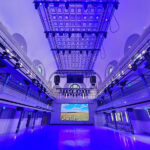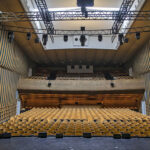We’re on our way to the Suffolk County Vanderbilt Museum’s recently renovated planetarium in Centerport, NY, which is on the north shore of Long Island. After undergoing 18 months and four-million-dollars worth of remodeling and technical upgrades, the facility reopened in March 2013 and was renamed the Charles and Helen Reichert Planetarium.
When we arrive at our destination we’re met at the foot of a stone pathway by Patrick Keeffe, director of communications for the Vanderbilt. Immediately, Keeffe draws our attention to sailing vessels, some in the foreground and others well off into the distance, dotting the expanse of Long Island Sound. The enormous 43-acre property and wide-lens vistas are breathtaking; it’s no wonder that the estate’s 24-room 1930s Spanish Revival mansion, now a natural history museum, was a summer getaway for wealthy adventurer, yachtsman and motor racing enthusiast, William Vanderbilt II.
Very little of the grounds has changed since the world traveler’s death in 1944 — an odd circumstance, considering that this retreat, dubbed “Eagle’s Nest,” is home to both high technology and a world that no longer exists. It’s a paradox, but one that offers us an intriguing start to our journey to the outer reaches of the solar system — and beyond.
Machine Uprising
Prior to the recent renovations, the 150-seat theater used what was once a state-of-the-art, if monstrous, GOTO slide projector run via DOS-based computer as well as other, smaller projector units. That’s all changed now. This is made abundantly clear upon entering the newly remade planetarium theater.
A massive Konica Minolta GeminiStar III Infinium L star machine rests on a scissor lift in the circular pit at the center of the space. The projector dominates the room, and its globular head, pockmarked with multiple lenses and secured by a crescent frame, resembles something out of George Lucas’ wild creations. In addition, a high-resolution, 4K, 10-megapixel JVC DLA-SH7NLG video projector is stationed in front of the GeminiStar III. (Another JVC DLA-SH7NLG, linked to the “planet projector,” which looks like a big, heavy blue box, is situated opposite the GeminiStar III on the other side of the pit and projects images of the Moon, Sun and planets in our solar system with a brightness of 5,000 lumens. Like other small and mid-sized planetariums, the Vanderbilt employs two video projectors — one to cover each hemisphere.)
The GeminiStar III star ball and video projection system beams the night sky, the solar system and other celestial bodies across the planetarium’s 60-foot projection dome — an aluminum mesh, which prevents the theater from becoming one big echo chamber and helping with airflow.
“The board built the planetarium because they felt that, if Vanderbilt, who was an explorer, were alive today he would want to take that next step,” says Lance Reinheimer, executive director. “[Building the Planetarium] was in lock step with the moon walk and Space Race in the 1960s, and in harmony with the way William K. Vanderbilt lived his life as an explorer and natural history collector.”
It’s difficult to shake the notion that Vanderbilt’s spirit is lingering here. Although he never witnessed the Apollo 11 Moon landing in July 1969, through the wonders of technology, NASA imagery and an ocean of stars — an entire universe — is literally at the planetarium’s fingertips.
Exploration of the unknown is what the planetarium experience is all about. It taps into the imagination, the sense of wonder of distant worlds (even ancient alien ones, now defunct), that Vanderbilt surely must have felt. The planetarium, which originally opened in 1971, also plays with the concept of timelessness and weightlessness, hinting at sensory depravation (or is it overload, given all the visual stimuli?), fusing past, present and future — a sensation brought on by a darkened theater and cutting-edge technology projecting cosmic imagery on a massive scale.
“Because of the fulldome video,” says Dave Bush, production and technical coordinator, “the planetarium creates a much more immersive environment.”
Rise of the Machines
Konica Minolta introduced the first generation of GeminiStar star ball machines in 1994, but this sophisticated piece of equipment has since been upgraded to offer a number of options to museums and planetariums around the globe. Miami, Florida-based Magna-Tech Electronic Company, which distributes Konica Minolta’s star machines, informed PLSN that there are only three GeminiStar IIIs in use in North America — two in the U.S. and another in Montreal at the Rio Tinto Alcan Planetarium.
Inside the GeminiStar III are dozens of lenses, behind which exist “star plates” containing holes created by precision lasers. Through fiber optic and laser technologies, the star ball can reproduce the location and proper magnitude of brightness of stars in the night sky. (The light source is a 6000K metal halide lamp.) The GeminiStar III can be customized depending on your needs.
“[Konica Minolta] called us up and asked, ‘How many stars do you want?'” says Bush. “We based our decision on how many stars we can see at the best viewing conditions at night. Of the entire celestial sphere of the nighttime sky you have a couple dozen stars that are brighter than the others. Each of those has its own individual projector [inside the star ball]. De Anza College, in California [the Fujitsu Planetarium], has the same exact star ball. We made a quick call to them and, basically, we went with what they did. We’re happy with the outcome.”
With the aid of binoculars, star clusters can be seen in greater detail. “You can even see star twinkling, because of a mechanism inside the machine,” adds Reinheimer.
“The only thing that’s difficult to see with this star machine is the Milky Way, and that’s because it’s dim and you have to be very dark-adapted in order to see it,” says Bush. “Your eyes have to adjust for, at least, twenty minutes in order to see that clearly. We augment the view of the Milky Way with the images from the video projector.”
Although we’re indoors — during mid-morning — the Vanderbilt has the ability to show us the nighttime sky on Long Island (on virtually any given day — past, present or future). After a few minutes everyone in attendance — PLSN, Reinheimer, Bush and Keeffe — has become “dark adapted,” and Bush operates the controls: a celestial view unfolds before us; stars dot the night sky and Bush points out that the Great Square of Pegasus.
“This is his belly button, called Alpheratz, and then you have two strings of stars that flow out from that — that fuzzy patch — which is the Andromeda Galaxy,” says Bush.
The Vanderbilt can take us anywhere. Before we know it, the night sky rotates and we’re at the South Pole. Bush draws our attention to two dwarf elliptical galaxies. “Here’s a part of the Milky Way we don’t get to see [in the Northern Hemisphere],” says Bush. “If I want to do constellation overlays for the southern portion of the sky, we can turn those on just by the click of a button, or we can do individual constellations,” says Bush. “Because [the system is] hybridized you can fast forward daily motion or the rotation of the celestial sphere and the video projector will follow it, so it looks seamless. The Konica Minolta star projector is the master and the Sky-Skan system, the digital video system, is the slave. You can either have the video on or off. Whatever you wish. You can simply use the star projector and forget the video altogether.”
We see an assortment of objects and shapes ranging from a grail or crater, to a telescope, to something resembling a Bunsen burner and laboratory glass jar. “Some of these constellations are not very well known,” says Bush. “You can add Milky Way or constellation overlays, whether they are stick figure or really nice classical illustrations.”
Embrace the Darkness
It sounds simplistic, but if the equipment doesn’t perform to theatergoers’ expectation the entire four-million-dollar upgrade can be called into question. “When the lenses are wide open, you get somewhat of a gray background,” says Bush. “That’s a drawback of all video projectors. They have a tough time projecting black.”
The Vanderbilt is aware of this, and that’s why it’s invested in some of the highest quality machines on the market. “What has made [the SH7NLG] projector so popular in planetariums around the world is the contrast ratio [a 10,000:1 native contrast ratio],” explains Tom Stites, special projects manager at New Jersey-based JVCKenwood Corp. “Most of the video projection technologies out there right now can’t achieve reasonably high brightness and a very low black level. Zeiss makes one that is up there in the millions of dollars, but it uses a different technology. The older CRT-based units could do it, but they were relatively low brightness and low resolution. You don’t want to be looking at a grey night sky. You want it to be as deep black as you can.”
It’s in this deep darkness that we’re rocketed off the Earth and hurling through space. “What’s good about the fulldome video is we aren’t stuck on Earth,” says Bush. “We can lift off and go anywhere in the known universe. There’s a data set in [the software], called Digital Universe, which was originally built off of the Museum of Natural History’s and Sciss’s product platform called Uniview. They are data points of every known star and galaxy within the known universe. With a lot of processing power and rendering we’re able to put these images out on the dome.”
Through Sky-Skan’s DigitalSky 2 software, run from a master computer, images are rendered and projected onto the dome. Thanks to GIS, a mapping feature, we can be standing, or sitting, safely within the confines of the Planetarium while simultaneously visiting the Mars, a moon of Uranus (pardon our French) or anywhere else in the mapped cosmos. “It’s sort of like Google Earth or Google Space, but a much higher resolution,” says Bush.
Using the program’s multi-window function, Bush calls up a video file that’s shown on the north side of the dome — behind us. It’s the famous Apollo 15 mission’s hammer-and-feather-drop test confirming Galileo’s theory of gravity. “We could place this video anywhere on the dome,” says Bush.
The Vanderbilt also has the ability to run and produce its own programs. “Part of the process of producing these types of programs is rendering out a lot of information, a lot of frames,” says Bush. “Most producers are producing content from 3-D animation programs, like After Effects, Maya and 3D Studio Max, to create some of the characters and environments. We can produce a program based on the visuals that are loaded in the system. We can go that route using still images, video images, panoramic scenes, static fulldome [images] and fly through space to go to any one of the moons or planets you choose. We can place 3-D characters or figures anywhere in the given space, whether on ground or in space.”
Stargazing
Urban legend tells us that planetariums of this type used to be the Holy Grail for stoners on Saturday nights while veg-ing out to the so-called space-rock sounds of Pink Floyd and such. It’s now, and, frankly, always has been, much more. Nonetheless, the Vanderbilt still hosts late-night activities, such as their surround-sound “Musical Space Journey” show (featuring 3-D animation, the music of Pink Floyd, Black Sabbath, Marvin Gaye and many others), along with educational and corporate events.
“In the past, lasers were just squiggly lines on the dome and people were wowed by that,” says Bush, who began working at the Planetarium in the year 2000. “There were ways to trick the audience into making them think the laser and other shows were more immersive by using star projectors and house lights. Both of these things pull your eye back.”
Today, of course, the fulldome video has the bases covered. However, never let it be said that the Planetarium has forgotten its roots. On Friday nights, Bush hosts an hour-long lecture, called Long Island Skies, which features a trip to the planetarium’s in-house observatory. Interestingly enough, the Vanderbilt’s 16″ Meade LX200GPS-SMT projector telescope can be linked with the theater’s digital system via a sensitive, real-time security camera. This means, of course, that planetarium guests might not need to step foot inside the observatory — or even look through a telescope for themselves.
Bush is skeptical about the practical application of this concept, however. Nothing beats looking at a planet in “real time.” “I think people still want to see Saturn with their own eyes,” Bush says.
And that’s the appeal of a planetarium, isn’t it? It brings the universe to us without ever having to leave Earth, making the Vanderbilt a kind of strange, wonderful place where magic seems to occur.
We bid farewell to the crew at the Vanderbilt and as we head out into the blinding afternoon sun, we’re suddenly aware that the universe is both smaller and infinitely larger than we had previously imagined. A paradox.
Somewhere, out there, Vanderbilt II is smiling.


